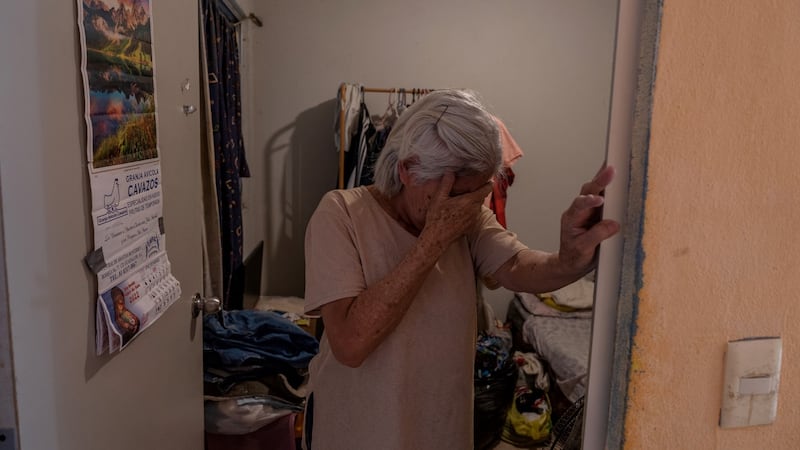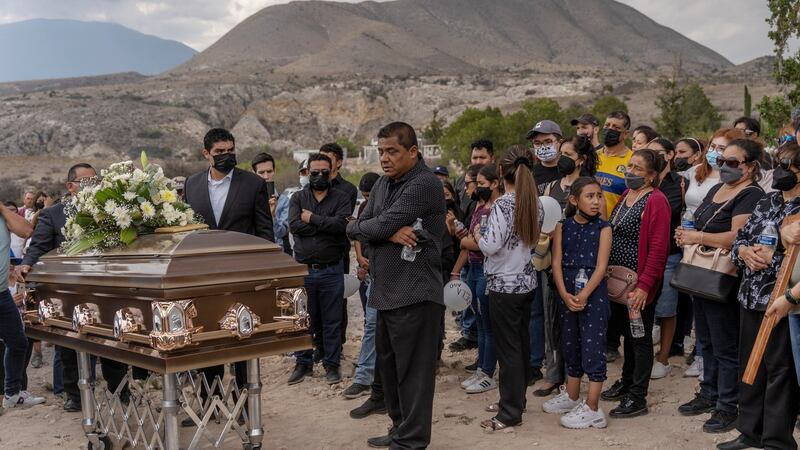On the 13th day of searching for his missing daughter, Mario Escobar stood outside a petrol station in the choking heat, clutching flyers with her photograph and the vestiges of a desperate, lingering hope.
Hours later, in a wash of red and blue police lights, that hope was destroyed. Debanhi Escobar's body was found the night of April 21st in an abandoned underground water tank on the grounds of a motel in northern Mexico, which authorities had already searched four times.
“I’m shattered,” Mario Escobar said of his daughter’s disappearance. “My life has changed completely.”
The case of Debanhi Escobar, an 18-year-old law student who disappeared on April 9th, has sparked outrage and protests over a phenomenon that is now chillingly common in Mexico: the disappearance of women and girls all over the country.

In just the past month, at least nine other women and girls have gone missing in the greater metropolitan area of Monterrey, one of the wealthiest cities in the country. Nationwide, more than 24,000 women are missing, according to government figures, and last year, roughly 2,800 women were reported missing, an increase of nearly 40 per cent compared with 2017.
The rising rate of disappearances correlates to the general surge in violence across Mexico in recent years, security experts say, in addition to the rise in organised crime, such as sex trafficking, as well as high rates of domestic violence that force many women to flee their homes.
But security analysts and human rights groups also point to a broader failure by state authorities to carry out proper investigations of missing women or prosecute femicide cases, fuelling a culture of deep-seated impunity. As a result, desperate families are forced to take search efforts and investigations into their own hands, seeking justice for loved ones who vanish into the wilds of an increasingly lawless nation.
“The state has simply completely turned its back on its responsibility to investigate cases of disappearances,” said Angélica Durán-Martínez, an associate professor of political science at the University of Massachusetts Lowell. “It’s an environment that makes it easier for these practices to continue propagating because there is no punishment or justice.”
Disappeared
A spokesperson for the prosecutor's office for Nuevo León state, which includes Monterrey and was responsible for the search and investigation efforts into Debanhi Escobar's disappearance, did not respond to multiple interview requests.
In a report released this month, the United Nations Committee on Enforced Disappearances called on Mexico to tackle the crisis, noting that more than 95,000 people are registered as disappeared. In the past five years, 8,000 people a year have disappeared. While most are men, the committee highlighted a "notable increase" in the disappearances of women, children and teenagers.
“Impunity in Mexico is a structural feature that favoirs the reproduction and cover-up of enforced disappearances,” the UN committee said in a statement, noting that as of November, only 2 per cent to 6 per cent of disappearances had resulted in prosecutions..
In response, President Andrés Manuel López Obrador, who made tackling Mexico’s violence a central campaign promise, said the committee’s recommendations were being addressed. In a news conference last week, he pledged the federal government’s support in solving Escobar’s killing and vowed that injustice in Mexico was a thing of the past.
“Along with corruption, what has hurt Mexico the most, because they go hand in hand, is impunity,” López Obrador said. “That’s why we talk about zero impunity, that the crimes that are committed be punished.”
But in Nuevo León, authorities have been more dismissive of the crisis. As recently as last week, the state prosecutor, Gustavo Adolfo Guerrero, cited a "lack of communication" among families as well as "rebelliousness" among teenagers as the cause of most disappearances of women, adding that most were missing as "a voluntary" decision.
Before Escobar disappeared, public outrage had already been building for weeks after a string of disappearances of young women in Monterrey, which seemed to underscore the negligence of authorities.

Yolanda Martínez (26), went missing March 31st. According to her brother Jesús, it took authorities two weeks to even visit their home. She has yet to be found. “It starts to feed our despair,” Jesús Martínez said. “I can’t tell you that they’re doing nothing, but I also can’t tell you what’s being done.”
Anger
Three days after Yolanda Martínez disappeared, María Fernanda Contreras (27) went missing. Through a family contact, Contreras's father, Luis Carlos Contreras, obtained cell tower data showing the approximate location of her phone the last time it was switched on.
Her father scoured the area, passing the information to the state prosecutor’s office. But he said it took authorities three days to close off and search the neighbourhood. By the time they found her, she had been dead for days.
“With all the information I had, I almost found my daughter, and these guys couldn’t do anything,” Luis Carlos Contreras said. “It’s ridiculous.” The Nuevo León attorney general’s office has denied it was slow to act, noting that María Fernanda Contreras was killed the night she disappeared.
Then came Escobar’s case, which intensified the anger. The uproar prompted a rare outpouring of public support, with people offering everything from drones to sniffer dogs to help the search. The night she went missing, Escobar had been at a party on the outskirts of the city. According to the state prosecutor’s office, Escobar left the party in a private car, but in the early hours of April 9th, she got out of the vehicle on the side of a highway, where the driver apparently left her.

The driver had been interviewed twice by investigators, according to an official in the prosecutor’s office who was not authorised to speak publicly.
Despite the staggering numbers, the cases of missing women are often downplayed or ignored by the media and local authorities, according to security experts, with officials frequently implicating women in their own disappearances or treating them as isolated incidents, not a systemic issue.
But with media attention building over the cases of missing women in Monterrey, authorities opened an investigation into Escobar almost immediately. A photograph of Escobar taken by the driver who left her on the highway also went viral, thanks partly to the family’s efforts to draw attention to the case. She’s pictured standing alone along a highway, arms crossed and staring into the darkness.
For nearly two weeks, her family and friends desperately searched, at times walking through barren fields, prodding at the dirt for signs of a buried body. Eventually, complaints of a foul smell by the motel workers tipped authorities off to check the water tank.
Nuevo León's top security official, speaking to reporters last week, acknowledged that the search for Escobar had been flawed. "It's a massive human failure," said Aldo Fasci, the state's security secretary. "They were there four times and didn't find anything."
Missteps
The cause of death was a head wound, according to the state prosecutor, Guerrero. In an interview last week with Reforma newspaper, he said she was dead before her body was dumped in the cistern. Then, on Wednesday afternoon, Guerrero told reporters that Escobar may have been alive when she fell into the tank.

"That is why the line of investigation is still open," he said. But the actions of state authorities have already been called into question. On Monday, Karla Quintana, the head of the National Commission for the Search of Disappeared People, pointed out several missteps by the prosecutor's office, including the failure to inform Escobar's parents that a body had been discovered, which they heard about on the news. They were then denied access to Escobar's remains and were provided only photographs, Quintana said.
The day after Escobar’s death was confirmed, hundreds of women took to the streets in protest, shutting down traffic across Monterrey. Many held the missing person flyers with the dead woman’s photograph.
On Saturday, Escobar's body was driven about three hours south of Monterrey to the town of Galeana, where her mother grew up. As the convoy of cars pulled into town, dozens of residents stood by the side of the road, waving signs and white balloons.

After a Mass inside a bare yellow church, the coffin was driven out of town, followed by a procession of dozens of people to the local cemetery, which sits on a hill overlooking soaring mountains. “We are destroyed inside; our hearts are broken,” Mario Escobar said. “We are sick and tired of everything that’s happening in Mexico.”
Debanhi Escobar's coffin was lowered into a grave lined with cinder blocks. Wet cement was poured on top, followed by dozens of flowers. Then, women in the crowd began singing a haunting hymn, their words whipped away by the wind. – This article originally appeared in The New York Times





















